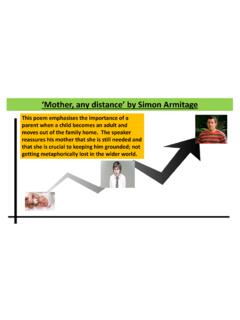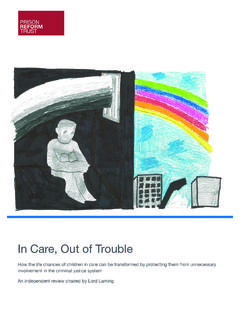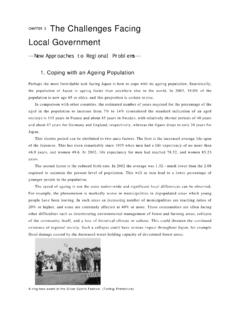Transcription of AQA English Language Paper 2 Writers’ Viewpoints …
1 AQA English Language Paper 2 : Writers Viewpoints and Perspectives Two non - fiction texts linked by the same theme or topic Source A is part of a speech that was delivered to the MPs in the Houses of Parliament in 1842 by a man named Lord Shaftesbury who was appalled at the working conditions of women and children in the coal mines across England. He wanted a new law to improve their working conditions. SOURCE A: Lord Shaftesbury s speech, 1842 Sir, the next subject to which I shall request your attention is the nature of the employment in the coal mines. Now, it appears that the common practice is to make young persons and children of a tender age drag carts of coal by means of a belt and a chain. This practice is common in Shropshire, in Derbyshire, in the West Riding of Yorkshire, in Lancashire, in Cheshire, in the east of Scotland, in North and South Wales, and in South Gloucestershire.
2 The child, it appears, has a belt bound round its waist, to which is attached a chain, which passes between the legs, and is attached to the cart filled with coal. The child is expected to drag it on all fours, and the chain passes under what, therefore, in that posture, might be called the hind legs; and thus they have to pass through passages not as good as a common sewer, quite as wet, and oftentimes more unpleasant. This kind of labour they have to continue for several hours, hours in a temperature described as perfectly unbearable. By the testimony of the people themselves, it appears that the labour is exceedingly severe; that the belt blisters their sides and causes them great pain. Sir, said one old miner, I can only say what the mothers say, it is barbarity - absolute barbarity. Robert North says: I went into the pit at 7 years of age. When I drew by the girdle and chain, the skin was broken and the blood ran down.
3 If we said anything, they would beat us. I have seen many draw at 6. They must do it or be beat. They cannot straighten their backs during the day. I have sometimes pulled till my hips have hurt me so that I have not known what to do with myself. In the West Riding, it appears, girls are almost universally employed to do the same work as boys. They commonly work quite naked down to the waist, and are dressed - as far as they are dressed at all - in a loose pair of trousers. These are seldom whole on either sex. In many of the coal mines the adult miners, whom these girls serve, work perfectly naked. Near Huddersfield the sub-commissioner examined a female child. He says, I could not have believed that I should have found human nature so degraded. Mr Holroyd, and Mr Brook, a surgeon, confessed, that although living within a few miles, they could not have believed that such a system of unchristian cruelty could have existed.
4 Speaking of one of the girls, he says, She stood shivering before me from cold. The rug that hung about her waist was as black as coal, and saturated with water, the drippings of the roof. In a pit near New Mills, adds the sub-commissioner, the chain passing high up between the legs of two girls, had worn large holes in their trousers. Any sight more disgustingly indecent or revolting can scarcely be imagined than these girls at work. No brothel can beat it. Surely it is evident that to remove, or even to mitigate, these sad evils will require a vigorous and immediate change to the law. That change is demanded by public reason, by public virtue, by the public honour, by the public character, and, I rejoice to add, by the public sympathy: for never, I believe, since the disclosure of the horrors of the African slave-trade, has there existed so universal a feeling on any one subject in this country as this.
5 5 10 15 20 25 30 35 SOURCE B: Taken from February 5th , 2014 CHILD LABOUR: INDIA S HIDDEN SHAME Two child protection officers hold her on either side as she walks into the police station. She was abducted four years ago from her village in north-east India. Until her rescue, she had been working in people's homes across West Delhi - cooking, cleaning and taking care of children. "I was not allowed to rest," she says. "If I did something wrong or it was not what they wanted, they hit me. If I wanted to sit down for a bit because I was so tired, they would scream at me. I was never allowed to leave the house, so I didn't realise that I'm in Delhi. My employers told me that we are in Madras in South India." As the police and counsellors question her, Lakshmi breaks down.
6 She tells the police that she was sexually assaulted by the men who kidnapped her. She was threatened that if she told anyone about it, they would tell everyone back home in her village and her honour would be destroyed. And then, when she started working the agent who arranged her work withheld all her wages leaving her with nothing. Her uncle is just relieved to have found her. A tea garden worker from Assam, he says her parents died when she was young and her grandmother is worried sick about the young girl. He is also angry about the abduction. "What can we really do? We are poor people - I didn't have enough money to come to Delhi to look for my missing niece. Unscrupulous agents and middlemen just come into our homes when parents are away working at the tea gardens and lure young girls with new clothes and sweets. Before they know it, they are on a train to a big city at the mercy of these greedy men.
7 " He is not alone. One child goes missing every eight minutes in India and nearly half of them are never found. Kidnapped children are often forced into the sex trade. But many here feel that children are increasingly pushed into domestic labour - hidden from public view within the four walls of a home. The government estimates half a million children are in this position. At a rehabilitation home in northern Delhi run by a charity for children, many families have gathered. They are all tea workers from the north-east state of Assam and have come here searching for their missing daughters. They estimate that just from one particular area - Rangpura in Assam - 16 girls have been lost in the last three to four years. Helping these families find their daughters is Kailash Satyarti, the head of one charity: "This is the most ironical part of India's growth.
8 The middle classes are demanding cheap labour," he says. "The cheapest and most vulnerable workforce is children - girls in particular. So the demand for cheap labour is contributing to trafficking of children from remote parts of India to big cities." Offering them a ray of hope is the case of 18-year-old Sumila Munda, who was rescued earlier this month. The information she provided led to police arresting a couple of alleged traffickers. She says she still has nightmares about her employers: "I don't want anyone to go through what I did. I often wondered if I will ever escape from the hellish life I was stuck in. I had dreams of being in school, studying. Now I will get back to my studies." 5 10 15 20 25 30 35 Q1: Read lines 1 to 14 of Source A. Choose four statements below which are TRUE.
9 Children dragged carts of coal by belt and chain Children only worked for a couple of hours The practice was common in west Scotland The children had to crawl on all fours The children find the work exceedingly severe The coal mine passageways were dry The temperature in the coal mines was unbearable Q2: Refer to Source A and Source B. Write a summary of the similarities and differences between the types of child labour. [8 marks] Q3: Refer to this extract from Source B. How does the writer use Language to show sympathy for the victims of child labour? As the police and counsellors question her, Lakshmi breaks down. She tells the police that she was sexually assaulted by the men who kidnapped her. She was threatened that if she told anyone about it, they would tell everyone back home in her village and her honour would be destroyed.
10 And then, when she started working the agent who arranged her work withheld all her wages leaving her with nothing. Her uncle is just relieved to have found her. A tea garden worker from Assam, he says her parents died when she was young and her grandmother is worried sick about the young girl. He is also angry about the abduction. "What can we really do? We are poor people - I didn't have enough money to come to Delhi to look for my missing niece. Unscrupulous agents and middlemen just come into our homes when parents are away working at the tea gardens and lure young girls with new clothes and sweets. Before they know it, they are on a train to a big city at the mercy of these greedy men." He is not alone. One child goes missing every eight minutes in India and nearly half of them are never found. Kidnapped children are often forced into the sex trade.


















